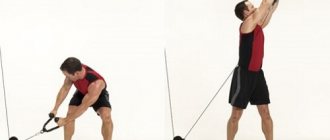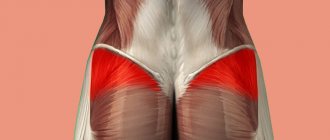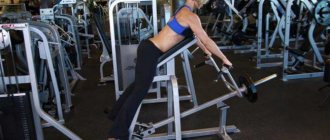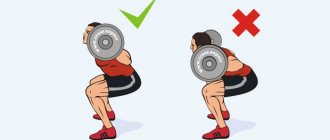Is all your hard work in the gym not yielding results? Try this muscle building workout program for yourself by working out three days a week.
Author: Mike Occhipinti
Wasted effort is a progress killer no matter the setting, whether it's a project at work that goes nowhere or a home improvement project you finish only to find out you need to tear everything down and redo it again. for measurement errors.
However, in the gym, too many people spend a lot of energy without stopping to question what they are doing. Day after day, month after month, even year after year, they follow an ineffective and ineffective program that is not exactly aimed at achieving their goals.
They don't look the way they want, or the scale doesn't move in the direction they want, they throw up their hands, shrug their shoulders and continue to waste their time and energy in the same spirit.
What solution? An updated training strategy that eliminates exercises and approaches that fail to build muscle mass, but doesn't compromise everything you need to fire up your body's growth engines.
The following three-day split offers one workout where you do pushing/pressing movements, a second day of pulling and a third day of legs, with one or two days of rest in between workouts.
No wasted effort. The training plan focuses on working larger muscle groups before moving on to smaller ones such as biceps and triceps.
Each session takes about 45-60 minutes, and for most body parts you only need 2-3 basic movement exercises. That's all you need if you train hard.
Read also: Arnold Schwarzenegger: a complete guide to his training.
Each of the presented sets is a working set, so you will need to add a few warm-up sets with light weights if necessary to get the blood flowing through the body and the muscles ready for work.
On each working set, the last rep or two—or even three—should be fairly challenging to perform.
The key to achieving lean muscle gains is to gradually overload the muscles, so make sure you gradually increase the weight over time.
Once you can complete the prescribed number of repetitions without much difficulty, it's time to increase the load in your next session.
Day 1: Push/Push Workout
The main focus here is on the chest, shoulders and triceps. For this and the next two workouts, tempo is a critical element of success.
Maintain a 3:1:1:1 tempo. This means you take 3 seconds to lower the weight, pause for 1 second at the bottom of the range of motion, and then raise the weight in 1 second while maintaining control of the movement. Pause 1 second at the top to eliminate any momentum generated and lock in the weight.
Why so slow during the eccentric phase of the repetition? Most strength gains occur during the eccentric phase, so you don't need gravity to do the work for you.
Push workout: tempo 3:1:1:1
Warm-up: arm abduction on a block for the rotator cuff – 2 sets of 10-15 repetitions
- Barbell bench press – 4 sets of 12, 8, 8, 5 reps.
- Incline dumbbell press – 4 sets of 12, 10, 10, 10 reps.
- Reduction of arms in a crossover from the upper blocks - 4 sets of 10-12 repetitions.
- Seated dumbbell press - 3 sets of 8-10 reps.
- Dumbbell lateral raises - 3 sets of 12-15 reps.
- Extension of arms on the upper block (using a rope handle) - 3 sets of 12 repetitions.
- Dips - 2 sets, until failure.
Read also: German volumetric training: how to use it to change your physical characteristics.
It's a win-win
The push-pull split trains your body from a functional standpoint, in line with the way you move and live. Think about something as simple as opening a car door: to perform this simple task, you use not only your fingers and biceps, but also your back, trapezius, rhomboids, rear deltoids, obliques, and a whole host of other muscles at the same time. This workout is designed to help you develop overall upper body strength.
With push-pull training, you fatigue the muscles that do the opposite action, so you can train more efficiently and recover faster than with traditional body part separation. By training in this way, you will quickly understand where your strengths and weaknesses are, and you will be better able to correct and compensate for them.
Additionally, this type of split allows you to cut your upper body training down to two days instead of the usual three or four. Follow a program like this for 4-6 weeks and you will begin to see results, such as increased strength and improved posture. What are you waiting for? It's time to start the upper body tug of war!
Day 2: Pull Workout
This workout focuses on the back, traps, biceps, and forearms. Injury prevention is always a priority, and the back is a particularly vulnerable area if you don't approach your training correctly.
Here and on all training days, technique takes precedence over everything, including the target number of repetitions.
Sure, it's great to achieve the required number of repetitions, but not at the expense of a crooked movement pattern. Avoiding injury is obviously the key to achieving your goals and developing your muscles as quickly and productively as possible.
Pull training
- Pull-ups on the horizontal bar - 5 sets of 8-10 reps.
- Deadlift - 4 sets of 6-8 reps.
- Bent-over dumbbell rows - 3 sets of 10 reps.
- Close-grip seated horizontal row - 3 sets of 10 reps.
- Raising arms in the simulator - 3 sets of 12 repetitions.
- Dumbbell shrugs – 2 sets of 12 reps.
- Standing dumbbell curls for biceps - 3 sets of 15 reps.
- Bending the arms from the lower block with a hammer grip (using a rope handle) - 2 sets of 12 repetitions.
- Seated barbell wrist curl - 2 sets, until failure.
Three principles for building a two-day split
The program is based on compliance with the following three areas:
- muscle mass should be divided exactly into two parts, which allows you to use 50% of the body on each training day;
- the back extensors and spine should receive extremely uniform loads;
- The shoulder joint moves over a large amplitude and is most susceptible to various types of injuries, which also imposes a requirement for the distribution of the applied load, which should be the same on each day.
The maximum load on the spinal column comes from deadlifts and squats. This is the reason why the back and lower extremities should be worked on different days. Experienced bodybuilders know about this feature and never train both of these muscle groups on the same day.
Following the third principle, also work out the deltoids and chest separately. There are no restrictions for the abdominal cavity. It is permissible to pump the press at any time. Recovery is achieved by taking a day break between workouts.
Day 3: legs
Great training programs must have a dedicated leg day, and this routine is no exception. By working all the major muscle groups of the lower body—quads, glutes, and hamstrings—in one session you move a lot of weight, activating the synergistic muscles that connect all of these body parts together. This is efficiency in action!
Read also: How often should you exercise?
For the other two workouts, the rest time should be 45-60 seconds, but on leg day you can increase the time to 60-90 seconds to allow those large muscle groups to fully recover for the next set.
Before starting your workout, perform a joint warm-up of your legs for 10 minutes, for example, using controlled joint rotation and mountain climber stretches.
Perform 2 warm-up sets of the first exercise with a lighter weight before increasing your working weight.
Leg workout
- Front squats - 4 sets of 5 reps.
- Bulgarian split squats with a barbell - 3 sets of 10 reps.
- Lateral lunges with dumbbells – 3 sets of 8 reps.
- Leg extension in the simulator - 2 sets of 12 repetitions.
- Seated leg curls - 2 sets of 12 reps.
- Gluteal bridge with additional weight - 2 sets of 12 repetitions.
By ditching your current routine and switching to this three-day split, you are essentially hitting the reset button on your program, getting rid of all the unnecessary exercises, changing set and rep patterns, and eliminating other problems that have been in your training for many years. years. If your old program was particularly complex, you'll notice the difference right away.
These workouts will make your muscles ache while still leaving you feeling pretty energized. They're short, simple, and built on exercises that are proven to be serious muscle builders. Try it and you should see big differences in the mirror within a few weeks.
"Pull - Push"
The essence of this split system is that in one workout you cover only those muscles that perform pulling functions, that is, the flexor muscles. These muscles include the back muscles, biceps of the arms, biceps of the thigh and forearm, and other muscles are extensors - performing pushing functions, these categories of muscle groups include the pectoral and deltoid muscles, triceps, quadriceps and calf muscles.
By combining muscles according to this characteristic, you ensure that, according to this characteristic, you ensure that after training they receive three full days of rest and recover perfectly. However, one should also take into account the fact that not only large muscle groups, but also small ones should receive an appropriate load (it is called finishing). The most important thing in this matter is not to overdo it, otherwise the small muscles will quickly overtrain and then generally stop responding to the load acting on them.
The split system we are considering also allows for a variable approach to training within a monthly cycle.
———————————————————————
Advantages and disadvantages of this type of training
For gaining muscle mass, the split system is considered perhaps the best tool. Especially when it comes to beginners and advanced athletes, that is, everyone who does not use illegal drugs. I consider the main advantages of splitting:
- The ability to effectively work each muscle in two workouts.
- Suitable for any type of training (strength, mass, endurance, etc.).
- There is no direct need to work with a trainer (the program can be easily compiled even with minimal knowledge. It is enough to understand the types of exercises and what muscles they load).
- No muscle imbalance.
- The central nervous system is not overloaded.
- No risk of overtraining.
- Suitable even for busy work schedules.
It doesn’t matter whether you work in a 5/6+1 mode, or in two-by-two shifts, setting aside 60-70 minutes twice a week won’t be difficult. This will be enough for stable growth if you take into account the progression of the load and do not constantly work with the same weights. Moreover, the split is completely universal, it is suitable for girls and women, older people and teenagers. Can be used both to prepare for competitions and during the rehabilitation period after injuries.
The split system has no obvious disadvantages; almost all the disadvantages lie in a negligent approach to the matter. Therefore, to eliminate potential disadvantages, you need to monitor the following features:
- Load planning (properly combine traction and pressing types of exercises, working out muscle groups, etc.).
- Maintain high intensity (rest, sets, repetitions, working weights and other factors). Remember, you only train twice a week, so your workouts should be intense.
- Monotony of training.
The last point for natural athletes, that is, athletes without pharmaceutical support, is the most destructive. Monotony quickly leads to adaptation, after which the body will not respond to the load properly (first of all, hormonal release decreases). This will lead to slower progression in muscle gain and loss of strength. Therefore, don’t make the same mistake that I’ve been seeing in gyms for years – don’t fall into a routine. Using the same split program month after month is truly suicide. With this approach, the effectiveness of training will constantly decrease. The maximum period for classes according to the same scheme is 8 weeks.
Conclusion
Despite frequent criticism, the split system is still considered a fundamental technique in bodybuilding. Its effectiveness has been known since the days of old photos of Arnold Schwarzenegger, where progress is visible when switching from a “full body” to a split. I also consider split the easiest training technique, which even a beginner can understand without any problems. This is one of the best ways to organize training, which I advise everyone to try without exception.
If the article was useful to you, and you want to further improve your knowledge and training effectiveness, then do not forget to subscribe. There are still many useful and unique articles ahead that will help you better understand the essence of the training and its secrets.
What can be replaced
The split system has only two obvious replacements - training the muscles of the whole body, which is still considered one of the most effective types of training, and specialized work. The latter category involves progression in specific exercises, such as powerlifting or weightlifting. There the program is structured in such a way that the main competitive movements are developed. Other exercises are supportive; they are needed to strengthen ligaments, hormonal response, train stabilizers and other purposes.
Full body training requires a special approach to planning. It will not be possible to exercise often with such a system, so you need to divide training into light (supporting) and heavy (developing). The second type should be performed on the whole body once a week, with heavy work until failure. Between heavy workouts, support ones are inserted. These can be anything from practicing technique, building endurance or low-intensity cardio for weight loss, to plyometric exercises.
What is split
The “split” technique, from the word to split or split, was popularized by the famous Joe Weider, the founder of bodybuilding. Its essence is to divide the workout into several parts, each of which is needed to work a separate muscle group (or several groups). This method of building a program makes it possible to progress well in bodybuilding while minimizing the number of classes.
I would like to emphasize that splits do not have strict rules or a clearly defined plan. This is a technique based on the principle of separation. Its implementation depends on specific goals and objectives. For beginners, it is better to focus on high-quality muscle development in two sessions, although splits for pros are most often divided into 3-4 workouts.
Who is it suitable for?
Middle-aged athletes should not use a two-day split. With age, the time required for muscle recovery increases and when using this method of training, a middle-aged athlete may not have time to recover. As a result, you can drive yourself into a state of overtraining. It's better to use a three-day or four-day split.
For experienced young athletes, this type of split is also not suitable. As muscle mass increases, the size of the load required for further muscle growth increases. In a two-day split, it is impossible to use a large number of exercises for one muscle group. As a result of this, an experienced athlete will not be able to give his muscles the required amount of training.
A two-day split is great for restoring muscle tone after a long break from training, for a speedy return to physical shape. If you started training after a long break, use a two-day split for 1-2 months, and you will quickly regain your previous shape.
It is often recommended to use a top-bottom scheme when creating a two-day split. That is, pump up the upper body in one workout, and the lower body in another. Such a split is not good. It turns out that in one workout 4 muscle groups work, in the second only two (and only if you train your legs).
The number of exercises for these two workouts is also incomparable. One has a minimum of 4 exercises (but there will be many more), the second has 2, maximum 3. Therefore, this method should not be used.
Training Tips
The main reason for lack of progression, injury and muscle imbalance is a violation of the training plan and technique. Therefore, it is important to remember the basic tips that will help you practice correctly:
- Remember that small muscle groups are most likely to be stressed in both sessions. Therefore, you cannot overdo it by adding unnecessary exercises for them. This applies to biceps, triceps, abs and partially deltoids.
- Aim to complete your core workout in one hour. This will allow you to finish before your body's cortisol levels begin to rise.
- Warm-up before strength work should include dynamic movements and cardio (5-10 minutes).
- Use supersets and dropsets in splits no more than once every two weeks.
- Try to ensure that the load is applied evenly to all muscle groups during the split.
Warm-up and stretching
Remember a simple truth. Warm-up is mandatory, stretching is highly recommended. Warm-up occurs at the beginning of the workout; without it, starting the strength part will unjustifiably increase the risk of injury, as well as deterioration in performance. Stretching after training will slightly reduce pain and speed up muscle recovery. Regardless of the load, you need to warm up and stretch all the muscles of the body.
Sets and reps
The number of sets and repetitions should be determined by the current goal of a particular cycle. For muscle gain, the optimal range is from 6 to 10 repetitions, strength development – from 3 to 6 repetitions. As part of losing weight, it is better to increase the number of repetitions in a set to 12-15, although a man can do it according to the standard scheme, simply by adjusting his diet.
Equipment
No equipment required. The only thing that will be relevant almost always is hand protection. Wearing gloves will help protect your skin and reduce pain when lifting heavy weights. The training belt should only be used on the last sets, when maximum weights are taken, but be aware of the compression it creates. Wearing a belt more than 45-50 seconds is strictly prohibited. I consider the use of straps and loops unnecessary, despite their popularity. This almost always causes the forearm muscles to lag behind and become the weak link in most exercises.
Weight of weights
It is considered optimal for a split system to work with weights of 60-65% of the one-time maximum. On the last approaches, it is allowed to take 70-75% of the load, but no more. To correctly track your working weights, I recommend keeping a diary or using your phone (any text document, application, calendar, etc.).
Nutrition and sports supplements
Mandatory supplements are protein, creatine (courses, 2 months on/1 month off), vitamin and mineral complexes and omega-3. If you lack energy and vigor before training, you can use green tea extract. BCAA is advisable only for morning cardio, 20 minutes before the start of training.
How many times a week to train
As much as your lifestyle and work schedule allows. The minimum reasonable number of classes per week is 2. The optimal number is 3. If you consider yourself an advanced athlete and have been training for several years, you can train 4 times a week, separating muscle groups more carefully.
Contraindications
There are no direct contraindications to the split system. That is, you need to take into account only general contraindications to strength training:
- Hypertension or high blood pressure.
- Curvature of the spine.
- Hernias and protrusions during exacerbation.
- Congenital heart defect.
- Liver and kidney diseases.
- During pregnancy.
In such cases, you can exercise only after consulting your doctor.











